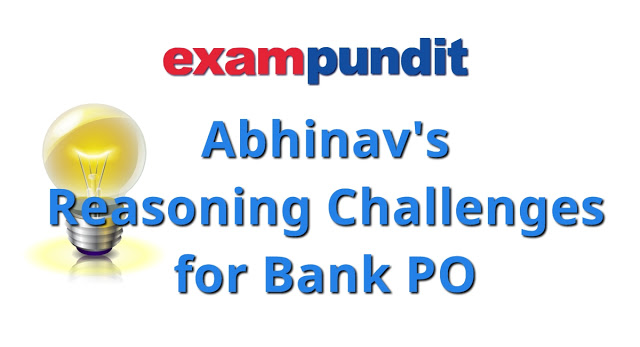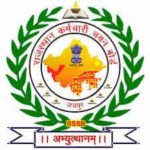Hello and welcome to exampundit . So here is the Abhinav’s Reasoning Challenges for Bank PO Exams 2016.
The rules are same as the fighter’s puzzle challenges(which is coming back).
Abhinav will conduct and help everyone along with the fighter and Chitrarth who will monitor/feature/delete any other comments.
Directions (1-5): In each of the questions below are given four
statements followed by four conclusions numbered I, II, III and IV. You have to
take the given statements to be true even if they seem to be at variance with
commonly known facts. Read all the conclusions and then decide which of the
given conclusions logically follows from the given statements disregarding
commonly known facts.
statements followed by four conclusions numbered I, II, III and IV. You have to
take the given statements to be true even if they seem to be at variance with
commonly known facts. Read all the conclusions and then decide which of the
given conclusions logically follows from the given statements disregarding
commonly known facts.
1. Statements:
a. All pencils are pens.
b. Some pens are syrups.
c. All syrups are needles.
d. Some needles are syringes.
Conclusions:
I. Some needles are pens.
II. Some pens are pencils.
III. Some syringes are needles.
IV. Some needles are syrups.
(1) None follows
(2) Only I and II follow
(3) Only I, II and III follow
(4) Only II, III and IV follow
(5) All follow
2. Statements:
a. All dusters are bins.
b. All bins are sepals.
c. No sepal is a root.
d. All roots are flowers.
Conclusions:
I. No flower is a bin.
II. No duster is a root.
III. All dusters are sepals.
IV. All flowers are roots.
(1) Only I and II follow
(2) Only III follow
(3) Only I, II and III follow
(4) All follow
(5) None of these
3. Statements:
a. All bulbs are lamps.
b. All lamps are stands.
c. Some stands are pens.
d. Some pens are benches.
Conclusions:
I. Some benches are bulbs.
II. Some lamps are benches.
III. Some pens are bulbs.
IV. Some pens are lamps.
(1) None follows
(2) Only I and II follow
(3) Only II and IV follow
(4) Only III and IV follow
(5) Only I, II and IV follow
4. Statements:
a. Some rulers are erasers.
b. All erasers are metals.
c. Some metals are papers.
d. All papers are bands.
Conclusions:
I. Some bands are rulers.
II. Some erasers are bands.
III. Some papers are rulers.
IV. Some metals are rulers.
(1) Only I and III follow
(2) Only I and II follow
(3) Only II and III follow
(4) Only II and IV follow
(5) None of these
5. Statements:
a. Some houses are beads.
b. Some beads are cycles.
c. Some cycles are tubes.
d. Some tubes are rains.
Conclusions:
I. Some tubes are beads.
II. Some cycles are houses.
III. No bead is tube.
IV. Some rains are cycles.
(1) Only I follows
(2) Only either I or III follows
(3) Only I and II follow
(4) Only either I or III and IV follow
(5) None of these
Sponsored
(adsbygoogle = window.adsbygoogle || []).push({});
Directions (6-10): Below is given a passage followed by several
possible inferences which can be drawn from the facts stated in the passage.
You have to examine each inference separately in the context of the passage and
decide upon its degree of truth or falsity. Mark answer
possible inferences which can be drawn from the facts stated in the passage.
You have to examine each inference separately in the context of the passage and
decide upon its degree of truth or falsity. Mark answer
(1) if the inference is “definitely true”, i.e. it properly
follows from the statement of facts given.
follows from the statement of facts given.
(2) if the inference is “probably true” though not
“definitely true” in the light of the facts given.
“definitely true” in the light of the facts given.
(3) if the “data are inadequate”, i.e. from the facts given
you cannot say whether the inference is likely to be true or false.
you cannot say whether the inference is likely to be true or false.
(4) if the inference is “probably false” though not
“definitely false” in the light of the facts given.
“definitely false” in the light of the facts given.
(5) if the inference is “definitely false”, ie it cannot possibly
be drawn from the facts given for it contradicts the given facts.
be drawn from the facts given for it contradicts the given facts.
A study conducted by a committee,
titled “World Class in India”, found the Indian bicycle industry to be globally
competitive. It projected the demand to grow from 117.2 lakh units in 2009-10
to 129.5 lakh units in 2010-11. However, all this has changed drastically
post-imposition of excise duty. According to All India Cycle Manufacturers’
Association (A1CMA). the production figure would be in the vicinity of 100 lakh
units. It says that against the net gain of excise duty of Rs 50 crore. the
Government has lost 29 lakh bicycles. Even if one assumes that the production
is less by 29 lakh units, the Government will lose Rs 122 per bicycle, which is
the excise duty paid actually on inputs by manufacturers. Thus the Government
has lost Rs 35 crore. Not to forget the losses in terms of 2 per cent central
sales tax (CST) and the state taxes which vary from 4-8 per cent. Assuming an
average of 6 per cent states tax and 2 per cent CST, the Government has lost
another Rs 25 crore.
titled “World Class in India”, found the Indian bicycle industry to be globally
competitive. It projected the demand to grow from 117.2 lakh units in 2009-10
to 129.5 lakh units in 2010-11. However, all this has changed drastically
post-imposition of excise duty. According to All India Cycle Manufacturers’
Association (A1CMA). the production figure would be in the vicinity of 100 lakh
units. It says that against the net gain of excise duty of Rs 50 crore. the
Government has lost 29 lakh bicycles. Even if one assumes that the production
is less by 29 lakh units, the Government will lose Rs 122 per bicycle, which is
the excise duty paid actually on inputs by manufacturers. Thus the Government
has lost Rs 35 crore. Not to forget the losses in terms of 2 per cent central
sales tax (CST) and the state taxes which vary from 4-8 per cent. Assuming an
average of 6 per cent states tax and 2 per cent CST, the Government has lost
another Rs 25 crore.
6. In the total bargain it seems that there will be a net
loss of Rs 10 crore to the government.
loss of Rs 10 crore to the government.
7. There will be no decline in domestic demand of bicycle in
2010-11.
2010-11.
8. AICMA acts as a liaisoning body with the government to
highlight the industry’s problem.
highlight the industry’s problem.
9. The reason for India’s export success in the past is the
large home base ofthe bicycle.
large home base ofthe bicycle.
10. Imposition of excise duty has unnerved the Indian
bicycle industry.
bicycle industry.
Regards
Team ExamPundit
This post was last modified on November 27, 2017 8:55 am





